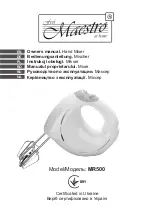
Owner’s Manual
Owner’
s Manual
“XLR” Connectors
Mackie mixers use 3-pin female “XLR” connectors on
all microphone inputs, with pin 1 wired to the grounded
(earthed) shield, pin 2 wired to the “high” (”hot” or
positive polarity) side of the audio signal and pin 3
wired to the “low” (“cold” or negative polarity) side of
the signal. See Figure A. This is all totally aboveboard
and in full accord with the hallowed standards dictated
by the AES (Audio Engineering Society).
Use a male “XLR”-type connector, usually found on the
nether end of what is called a “mic cable,” to connect to
a female XLR jack.
1
⁄
4
" TRS Phone Plugs and Jacks
“TRS” stands for Tip-Ring-Sleeve, the three
connections available on a “stereo”
1
⁄
4
" or “balanced”
phone jack or plug. See Figure B.
TRS jacks and plugs are used in several different ap-
plications:
• Stereo Headphones, and rarely, stereo micro-
phones and stereo line connections.
When wired for stereo, a 1⁄4" TRS jack or plug
is connected tip to left, ring to right and sleeve
to ground (earth). Mackie mixers do not
directly accept 1-plug-type stereo microphones.
They must be separated into a left cord and a
right cord, which are plugged into the two mic
preamps.
Appendix B: Connections
You can cook up your own adapter for a stereo
microphone adapter. “Y” two cables out of a
female 1⁄4" TRS jack to two male XLR plugs,
one for the Right signal and one for the Left.
• Balanced mono circuits. When wired as a bal-
anced connector, a 1⁄4" TRS jack or plug is con-
nected tip to signal high (hot), ring to signal
low (cold), and sleeve to ground (earth).
• Unbalanced Send/Return circuits. When wired
as send/return “Y” connector, a 1⁄4" TRS jack
or plug is connected tip to signal send (output
from mixer), ring to signal return (input back
into mixer), and sleeve to ground (earth).
1
⁄
4
" TS Phone Plugs and Jacks
“TS” stands for Tip-Sleeve, the two connections avail-
able on a “mono” 1⁄4" phone jack or plug. See Figure C.
TS jacks and plugs are used in many different
applications, always unbalanced. The tip is connected to
the audio signal and the sleeve to ground (earth). Some
examples:
• Unbalanced microphones
• Electric guitars and electronic instruments
• Unbalanced line-level connections
Switched
1
⁄
4
" Phone Jacks
Switches can be incorporated into 1⁄4" phone jacks,
which are activated by inserting the plug. These switch-
es may open an insert loop in a circuit, change the input
routing of the signal or serve other functions. Mackie
uses switches in the channel insert and bus insert jacks,
input jacks and AUX returns. We also use these switches
to ground the line-level inputs when nothing is plugged
into them.
In most cases, the plug must be inserted fully to
activate the switch. Mackie takes advantage of this in
some circuits, specifying circumstances where you are
to insert the plug only partially. See Special Mackie
Connections, on the next page.
SLEEVE
TIP
TIP
SLEEVE
TIP
SLEEVE
SLEEVE
TIP
SLEEVE
TIP
RING
RING
TIP
SLEEVE
RING
Figure C: TS Plug
2
2
3
1
1
SHIELD
COLD
HOT
SHIELD
COLD
HOT
3
SHIELD
COLD
HOT
3
2
1
Figure A: XLR Connectors
SLEEVE
TIP
TIP
SLEEVE
TIP
SLEEVE
SLEEVE
TIP
SLEEVE
TIP
RING
RING
TIP
SLEEVE
RING
Figure B: " TRS Plugs








































